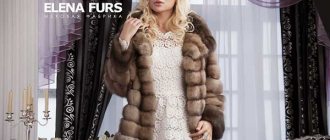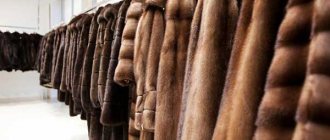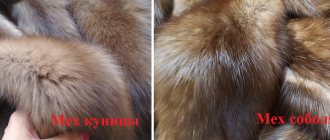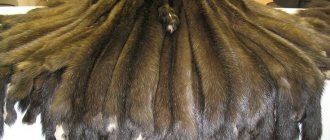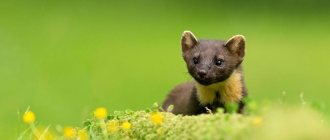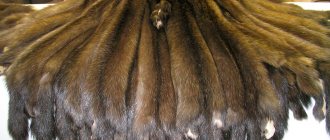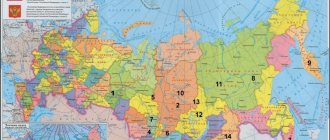The natural characteristics of marten fur make it one of the most popular materials for sewing winter clothing. In some qualities he occupies a leading position.
The high characteristics of this fur have been known since ancient times. There were periods when marten skin played the role of money, which was called kun. For its lush hair and pleasant texture, marten fur was called “soft gold.” Now it is also in high demand and is used to create both entire clothing and collars and other accessories.
Types and characteristics of marten fur
The marten is a wild animal that can only be found in its natural habitat. All attempts to breed and set up mustelid farms have failed. Even in the zoo you rarely see them. Hunting for marten is prohibited, only trapping, which is strictly limited.
Difficulties in harvesting make fur so expensive and exclusive. For commercial purposes, pine and stone marten furs are used. Sable also belongs to the mustelid family, but its fur is considered more valuable.
Marten fur coats
Lesnaya
The pine or noble marten with soft fur and thick underfur is distinguished from its relatives by a bright yellow spot on the neck.
Cost of popular models ^
The price of such clothing depends on a number of factors. Here are the approximate prices for the most common models of these clothes.
A short version of a fur coat (transverse version) with a back length of 90 cm and ¾ sleeves will cost 247 thousand rubles.
An extravagant lilac jacket with a grayish tint (length - 47 cm), decorated with python skin and having a zipper, will cost approximately 230 thousand rubles.
Spectacular golden peach marten coat with short sleeves (3/4), the material is laid in a horizontal wave. Price: 280 thousand rubles.
A short sheepskin coat (length - 60 cm) with a stand-up collar and astrakhan fur trim will cost 540 thousand rubles.
Kunya jacket with a collar and silver buttons, color – golden sand. Cost – about 300 thousand rubles.
A fur coat with a belt and an ornament made of snake skin; wheatear marten fur was used as raw material. Price – 500 thousand rubles.
Elegant jacket made of Japanese marten with silk lining. The price in online stores is about 200 thousand rubles.
A good way to save money is to buy a marten coat on sale, in which case the discount can reach 20-50%!
Advantages of marten
Marten fur has many advantages - softness, beauty, lightness. But the main thing is practicality. Thanks to the hard and thick undercoat, the products are very durable. For 7-10 years, marten fur coats retain their appearance. Thanks to the ventilated structure of the pile, dust does not accumulate on the fur coat, which makes it safe for allergy sufferers.
Fur products
Not just a fur coat... or what is better to wear such clothes with? ^
An expensive marten fur coat is too luxurious a product for drab everyday life. Like evening dresses, it should be worn for going out.
Of course, jeans in this case will be absolutely inappropriate. It is much preferable to wear narrow trousers of a classic cut (from 1200 to 3500 rubles) or a short skirt (from 800 to 1500 rubles) , which can be part of an elegant tight-fitting dress.
It is important that the skirt or dress is completely covered by the skirts of the product (we are talking about a shortened version or a short fur coat), and not peeking out from under it.
A luxurious, elegant thing made from such material is glamor in its purest form, it is simply impossible to imagine it with low-soled shoes.
Only high-heeled boots, possibly with high tops or over the knee boots (from 2100 to 3200 rubles) . The color is better classic, black, brown or beige, and certainly matches the handbag (from 900 rubles).
A scarf or hat (up to 4,500 rubles) , as well as a belt, will help complement the bright image of a woman-temptress The latter should be wide enough (850 - 2400 rubles), because marten fur has a long and voluminous pile.
What is the difference between sable and marten
For an inexperienced buyer, distinguishing sable from marten fur is an impossible task. This is exactly what enterprising sellers of fur clothing take advantage of.
After painting, things look exactly the same, but if you look closely, you can find the difference.
- Price. Like American mink, marten and sable are considered the most prestigious. But there is a difference in price for fur coats, hats, and clothes made of sable - it is noticeably higher.
- Wearability. Sable fur coats, according to owners, last for 16-17 years thanks to the elastic and thin skin.
- The difference is in the density of the pile. Sable is thicker and the axial hairs are much softer, as can be seen in the photo.
- Color. The marten is predominantly brown in color, while the sable's fur is much richer and its undercoat is a noble smoky color. That is why the marten is tinted to hide the difference and pass it off as a sable.
- Another difference between the fur of marten and sable is the unique and luxurious shine of the latter.
Processing and quality of marten skins
Varieties of martens
In merchandising, the skins of pine marten are called soft marten, and all because its fur is similar in quality to sable fur, only a little coarser and not so thick and lush.
The range of the forest animal is very extensive, it covers almost the entire forest and forest-steppe zone of the European part and regions of Western Siberia of Russia. Individuals caught in different areas of this vast territory have a number of distinctive features. In this regard, all skins are divided into several varieties.
1
K. kubanskaya
Distributed in the Caucasus. The skins have an average length of about 55 cm. The fur is thick, of medium fluffiness, somewhat rough in comparison with other varieties. The guard hairs are not very long. The general color is dark chestnut, the sides have a reddish-sand tint. The entire fluff is bluish-gray, except for the ends of the hair, which are reddish. The throat spot is orange. The tail is the longest of all varieties.
K. central
Skins of this variety come from regions located in the central part of Russia. The dimensions are small: the average length is 47-49 cm. The fur is not very fluffy, the softness is slightly better than that of the Kuban marten, but inferior to other varieties. The spine and ends of the downy hairs are colored reddish-brown, which overall gives the fur a well-defined reddish tint. The throat spot is bright, almost orange.
K. western
Distributed in the western regions of our country, bordering the Baltic states, Belarus and Ukraine. The size of the skins is smaller than that of the Kuban and Murmansk martens. The fur is quite thick, soft and lush. There are different color shades, but most often it is dark chestnut. Blue fluff.
K. northern
Habitat: northern regions of the European part of Russia. The sizes are small, the same as those of the central marten. The skins have tall, thick, lush and silky fur. The color is varied. Most have a light shade of hair. The color of the guard hairs varies from pale brown to light brown. The fluff is bluish-gray. The throat spot is light, the color is yellowish or whitish.
K. murmanskaya
Distributed on the Kola Peninsula and Karelia. The skins are large: the length, like that of the Kuban marten, is 55 cm. The fur is the most lush, thick and silky among all varieties. The color is mostly dark, chestnut, with no red tints. The fluff is blue throughout the hair.
K. uralskaya
It comes from the Urals and neighboring areas. The size is quite large, only slightly inferior in length to the Kuban and Murmansk martens and is about 53 cm. The fur is lush and silky, and has a light overall color. The guard hairs are light brown, the fluff is almost white, only on the rump with a yellowish tint. The throat spot is yellowish or whitish.
Categories or color forms
In addition to varieties, soft marten skins are divided into four color forms:
1) Dark blue
The fur is dark chestnut in color without red tints. The down is blue-gray at the base and light gray at the top.
2) Blue
The guard hair is brown in color. The fluff is gray.
3) Dark sand
The fur is brown or dark sand, there is a reddish tint, especially on the sides of the skin. The down is gray at the base and light sandy at the ends.
4) Sand
The cover is light brown with a light yellow tint. The down is gray at the base, yellowish at the tops.
Dark blue fur is considered the most valuable
Differences between marten and sable fur
The skins of sable and soft marten are very similar, but have a number of distinctive features.
- The color of the head is greyish in the first animal, lighter than the ridge, in the second it is the same as the ridge.
- The shape and color of the throat spot is round or oval in sable with unclear boundaries, with a color from gray-yellow to gray-orange. In the marten, the shape of the spot is elongated, extending like a wedge onto the chest, the boundaries are clear, and the color ranges from white to orange.
- The fur of the inhabitant of Siberia is soft, silky, and very thick. The awn is short, slightly protruding above the down, the color varies from chestnut to almost black. The down is blue-gray at the base and chestnut at the ends. The resident of the western forests has fur that is slightly less soft and silky. The spine protrudes significantly above the down, its color is chestnut with a yellowish or reddish tint. The down is gray at the base, with a yellow or red tint at the top.
- The tail is not as long and bushy as that of a marten, the color is slightly darker than the ridge. She has one and a half times longer than her hind legs and is darker in color than her spine.
2
The predator molts twice during the year - in spring and autumn.
Signs and evaluation of skins by season
First grade (winter).
The fur is fully formed, tall and dense, consisting of high, dense, shiny awns and thick down. The tail is bushy. The flesh is thin, without blue.
First grade, second group of defects (late winter).
The hair is still tall and thick, but already slightly faded and slightly thinning on the sides and the belly. The tail is bushy. The flesh is thin, without blue.
First grade, third group of defects (early spring).
The hair is overripe and dull. The awn and down on the sides and belly are noticeably thinner. The skin is slightly thickened, there is no blue discoloration.
First grade, fourth defect group (spring).
The fur is dull and has lost its elasticity. The awn and down on the sides and belly are very thin. The mesdra is thickened, without blueness.
Non-standard (late spring, summer, early autumn).
At the end of spring, dull fur already falls out over the entire area of the skin. Summer hair growth begins. The mesdra is thickened and blue. Summer - low, sparse and almost without fluff. The skin is thickened, but without blueness. At the beginning of autumn, new hair is just beginning to develop. The awn is frequent and short, the down is very low. The mesdra is thickened and blue.
Third grade (autumn).
The new fur is still quite short. The awn weakly protrudes above the down; the down has only grown by half. The skin is thickened and blue.
Second grade (early winter).
Thick, shiny, slightly less tall and fluffy fur than on winter skins. The flesh is slightly thickened, blueness is present on the tail and rump.
It should be noted that at present, as when accepting most other skins of fur-bearing animals, defectiveness groups are not taken into account in most procurement organizations
Primary processing and cost
The skins are removed with a tube, preserving the head, tail and paws with claws. When shooting, first of all, an incision is made along the rump, starting from one hind leg, through the anus, to the other. On the front legs, we make an incision from the pads of the paws to the hock joint. Next, having trimmed the skin around the rectum, remove the skin from the hind paws, keeping the claws; the toes are cut off at the last joint. Then we remove the tail vertebrae and cut the tail along the inside. Having pulled the skin to the front paws, we release them, also preserving the claws. By trimming the cartilage on the head, we finish removing the skin.
We degrease the removed skins well, avoiding damage to the hair. We thoroughly clean from dirt, blood from the fur and leather tissue, remove all cuts from muscles, tendons and cartilage.
Marten skins are straightened mainly on wedge-shaped rules. First we put it on with the inside out, straightening it out well. To avoid curling, place clean paper on the front paws. We attach the tail and hind legs to the straightener with nails. At the end of drying, remove it from the straightener, having previously removed the protruding droplets of fat on the flesh, and turn it inside out. We put it on again and dry it.
3
Raw materials, as noted above, are preserved using a fresh-dry method and straightened, adhering to a width-to-length ratio of 1:5 or 1:6.
Marten fur is very valuable, and knowing this, many hunters approach the primary processing process more carefully. But despite this, very often furs with various defects are handed over. Most of them are lifetime. The marten leads a semi-arboreal lifestyle; therefore, the two most common defects are often observed: wear of the fur and contamination of the hair with resin from coniferous trees. The first species can be excluded by hunting the animal, if possible, in the first half of winter.
When removing resin from fur, under no circumstances, even if several hairs are contaminated, do not pull them out. We get rid of resin using turpentine, acetone or gasoline. After dissolving it with the above agents, wipe the treated areas with a clean cloth moistened with warm water. When fishing for martens with traps, the following defects occur: prelines, holes, damage to paws. When hunting with a gun, you mainly encounter lumbago and bloody skins.
Currently, the main criteria that determine the cost of pine marten fur are the size of the skin, height, hair density, color and absence of defects. The price at the beginning of the season (2011/12) was 1,400 rubles, and at the end it reached 2,000 rubles. Season: 2012/2013 - 2500-2800 rubles, 2013/2014 - 2500-1700 rubles, 2014/2015 - 2300-3000 rubles. 2018/2019 - 2200-2300 rubles (February ones with scuffs no more than 1000 rubles)
What kind of habitat does this animal prefer and what kind of lifestyle does it lead? Read in the article “Biology of the pine marten.”
How to choose a fur product
Sable and marten fur is used for sewing women's and men's outerwear, hats, collars, and decorative elements, especially in designer models.
When buying such things, you need to know what to look for and how to distinguish a fake:
- The first thing you need to pay attention to is the mezdra. The buyer has every right to ask the seller to slightly tear off the lining to see the back of the skin. It should be elastic, easily bendable, light in color and not rustle on the fabric.
- Check the elasticity of the hairs. In good fur, after pressure they quickly return to their original shape.
- Run your hand against the growth of the hairs - they should immediately fall into place without breaks or hesitations. If this does not happen, the fur may be damaged. Also, hairs should not fall out and remain on the palm.
- Inspect for rust. Sables and minks are often kept in cages, and the rods leave marks on the skins that cannot be washed off.
- Check the country of origin. Clothes made from sable are made exclusively in Russia.
- Lightness of even large products. Judging by the reviews, the weight of a mink or marten coat is practically unnoticeable.
- A durable product is distinguished by the number of seams - the fewer there are, the higher the wearability of the item.
Where to buy: review of stores and prices
The shops: Addresses: Website: Prices from (RUB): The shops: Addresses: Website: Prices from (RUB): MechGrad Moscow, Kolpachny lane, 9c1 Ekaterinburg, st. Kuibysheva, 44 St. Petersburg, Suvorovsky prospect no. 18 https://www.mehgrad.ru 240 000 Northern Fox Moscow, Institutsky lane, 12 https://severnylis.rf 200 000 My Fur Moscow, st. Dokukina, 12 https://moimeh.ru 230 000 FurMond Moscow, Baumanskaya street, building 7, building 1 https://furmonde.ru 165 000 KingSobol Moscow, Marshal Zhukov Avenue, 59 https://kingsobol.ru 160 000 Triumph Moscow, Prospekt Mira, 105, building 1 https://www.evro-mexa.ru 200 000 Camphor Moscow, st. Dokukina, 10, building 10 https://kamfur.ru 149 000 Fur Lux Market Gardener https://mexa-lux.ru 148 000 Kalyaev official site https://www.fursk.ru 149 000 World of Furs Moscow, Dokukina st., 10 https://www.mir-shub.ru 120 000 Emil Shabaev Moscow, st. 1812, no. 2 https://emilshabaev.ru 350 000 Elena Furs official site https://elenafurs.ru 261 000 Lapland Moscow, metro station Alekseevskaya https://l-norka.ru 170 000 Addresses
Sable and marten products are a valuable acquisition and a luxurious gift for yourself or loved ones. Such things are distinguished by an abundance of colors, beauty, durability and uniqueness.
Kasapis Bros^
Founded in 1979, this Greek company has managed to accumulate considerable experience in the production of fur clothing.
Fans always look forward to the shows of Kasapis Bros collections with great anticipation, because it is not only a celebration of design art, but also a whole fountain of surprises and new ideas that connoisseurs of winter clothing throughout Europe are happy to pick up.
Dear visitors!
If you know how to count money and regularly buy things on the Internet, then we recommend reading our article about how you can return part of the money spent on a purchase using so-called cashback services.
We have selected the 3 best options, you can return up to 30-40% of the cost of an item purchased online (clothes, bags, shoes, whatever)!
So, read our article “Top 3 cashback (money back) services when buying clothes and accessories in online stores” and save your money, because money saved is money earned.
We also recommend that you read our article about the 3 best online stores for buying mink coats; you can save a lot of money when purchasing without sacrificing the quality of the item, especially since now it’s sales time!
We choose a fur coat to make everyone jealous
Marten fur looks beautiful on the edges of hems, cuffs, collars, as a trim for coats and gloves, bags and hats
Marten fur is very practical. It is so light and flexible that you can sew luxurious floor-length models from it. This is an excellent material for sewing outerwear (fur coats, short fur coats, stoles, hats, coats), which does not fade and remains lush and shiny even after 6-7 seasons of continuous wear. Another undoubted advantage of this fur is its hypoallergenicity. The skins are well “ventilated”, so that there is no dust left among the fibers, which causes allergies. In addition, unlike sables, martens do not have a sharp, specific “animal” odor, which is difficult to get rid of even with repeated treatment.Symetrie^
The name of the brand was not chosen by chance, because we associate the concept of symmetry with harmony and impeccable perfection, which are so characteristic of the products of this brand.
In the collections from Symetrie, every woman, be it a business lady or a fan of extravagant outfits, will find a model to suit her taste.
Timeless classic - mink fur. Its fur coats look beautiful, allowing you to emphasize the status and attractiveness of its owner. For information on how and where to buy such an item, read the article The best ways to buy a mink coat inexpensively: tips, reviews and prices, only for readers of our online magazine!
We also advise you to read the information about fur coats made from black and brown fox; they are not as familiar as mink, allowing you to attract attention from surrounding men. You can read everything about cost, suitable accessories, the most famous manufacturers here, create your own unique image and be attractive always and in any situation!
Fur coats made from sable look expensive and beautiful. Read more about such fur coats, what to wear them with, how to choose the right one and much more here.
Di Cara^
If you are interested in truly exclusive fur clothing, choose Di Cara, just be sure to prepare a mind-boggling amount of money.
Di Cara clothing is a peak, a standard of perfection, a dizzying height, accessible only to a select few. The company's management abandoned the traditional strategy aimed at maximum market coverage and relied on the production of a small number of extremely expensive handmade products.
Each model in the Di Cara collections is a work of art, for the production of which only reference material is used.
